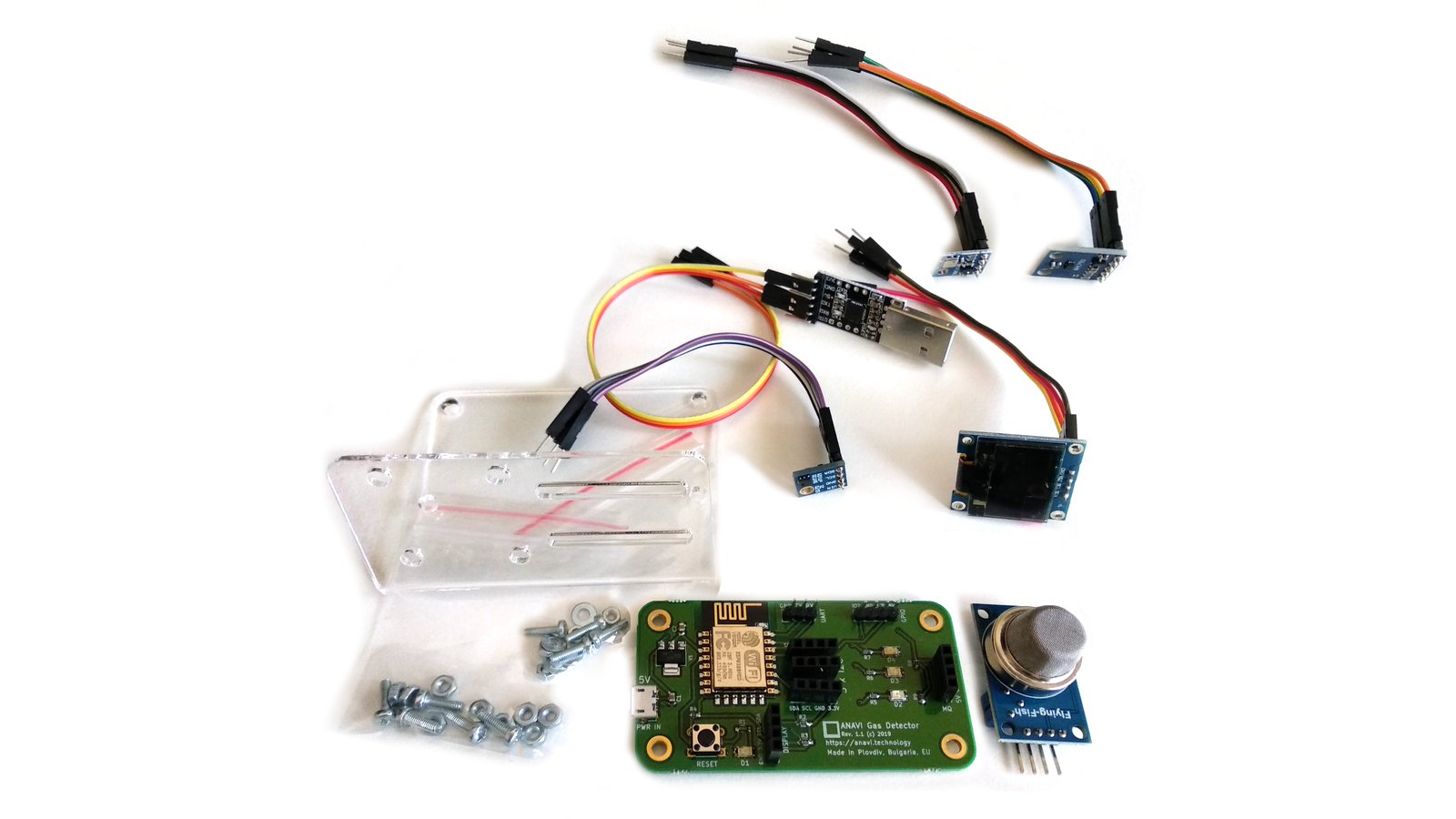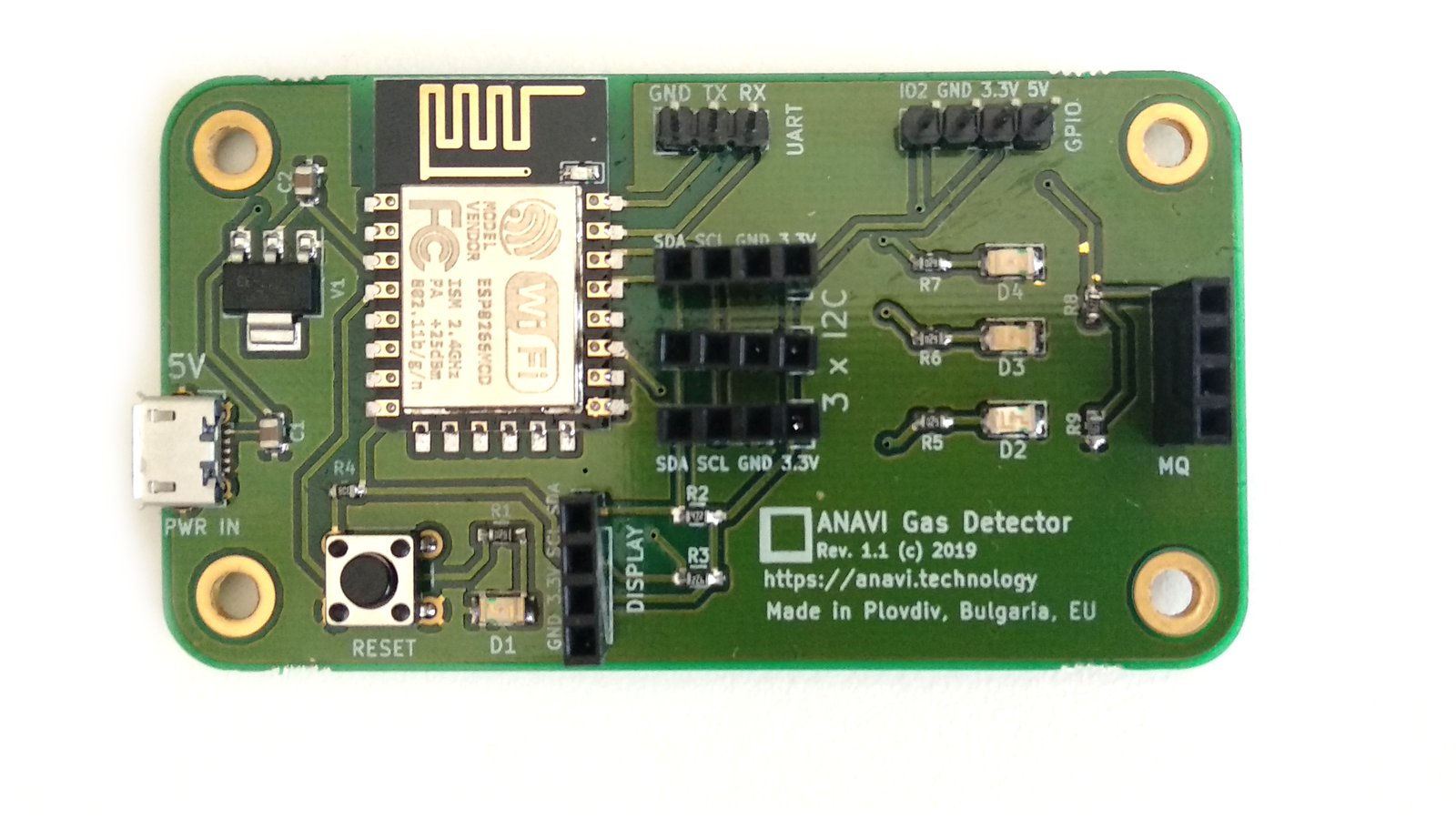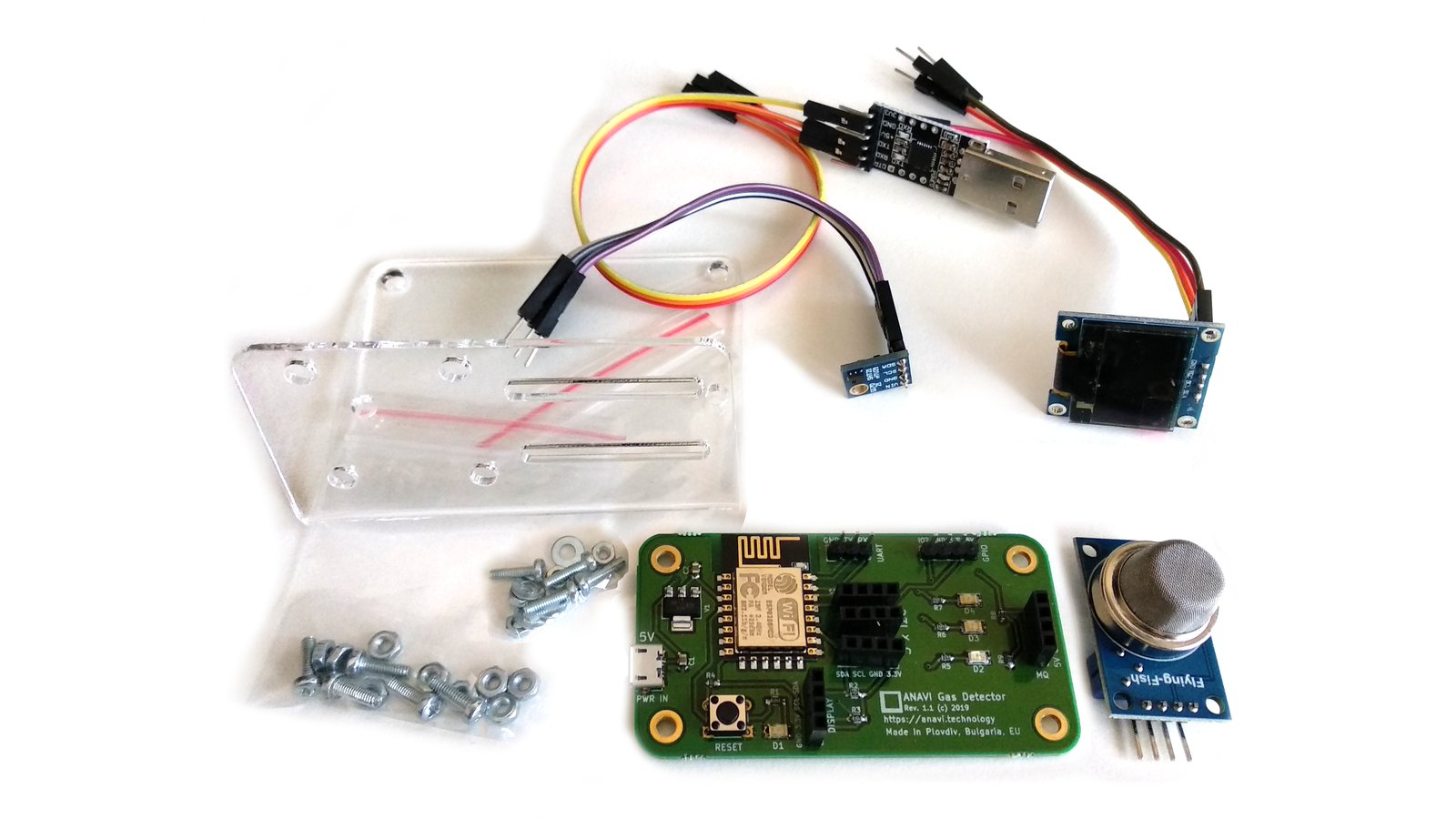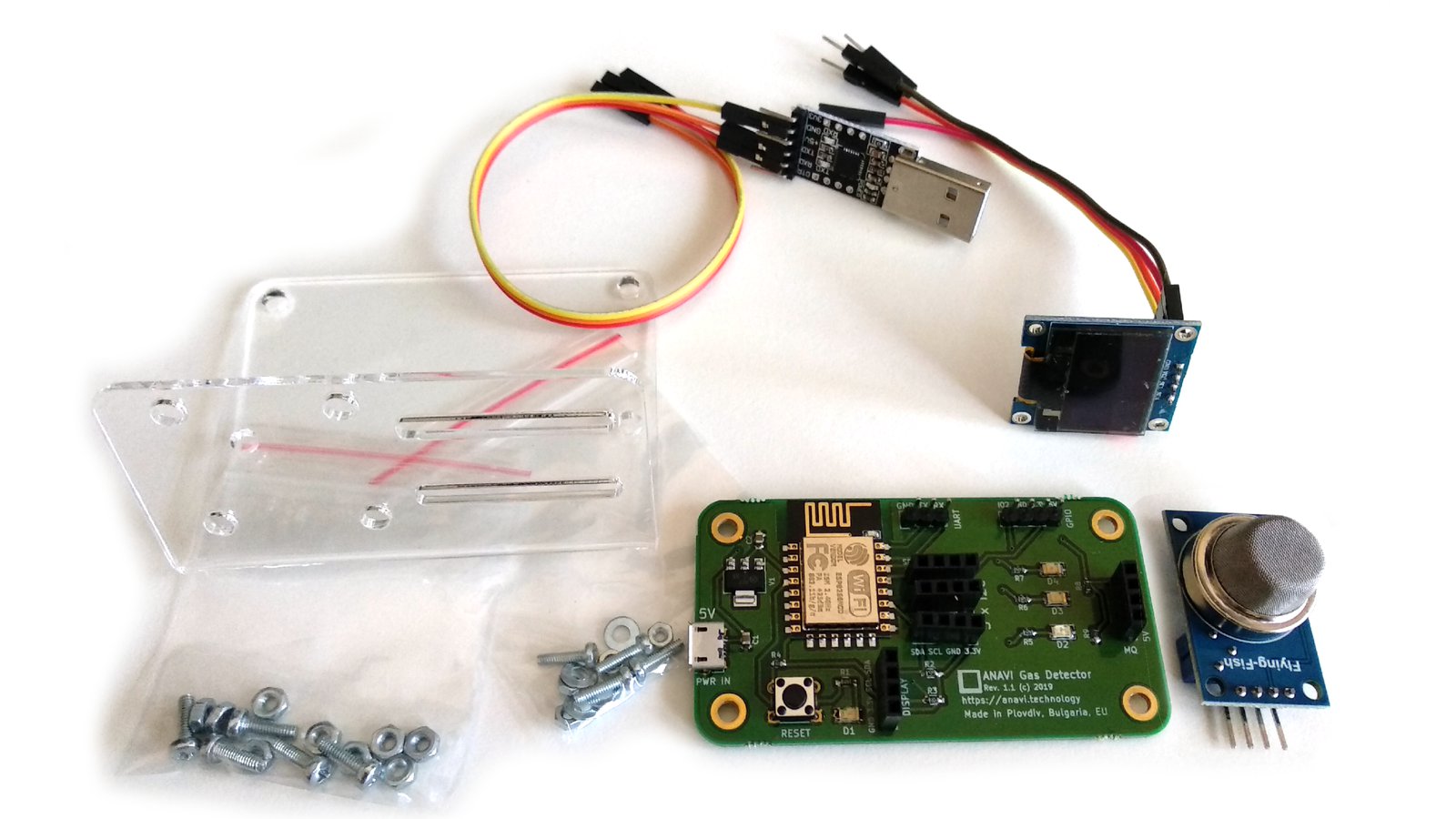ANAVI Technology
Environmental Sensing
KiCad
ANAVI Technology
Environmental Sensing
KiCad
ANAVI Gas Detector is an open source, easy-to-use, Wi-Fi compatible development board for monitoring air quality and detecting dangerous gases. It supports popular analog MQ gas sensor modules such as MQ-135, MQ-2, MQ-3, etc. Furthermore, it comes with slots for mini OLED display and up to three additional I²C sensor modules, including the precise digital sensor HTU21D for measuring temperature and humidity.
Air pollution is a very serious problem. Monitoring air quality and detecting toxic gases can improve one’s quality of life. All these features make ANAVI Gas Detector appropriate for developers, makers, students and open source enthusiasts who are interested in home automation and an environmentally friendly lifestyle.
Getting started with ANAVI Gas Detector is easy. No soldering is required. To turn on ANAVI Gas Detector, just plug a standard USB charger into its microUSB connector. A comprehensive user’s manual with exact steps for using all the features of ANAVI Gas Detector is available.
ANAVI Gas Detector is fully compliant with Arduino IDE, PlatformIO, the popular open source home automation software platforms Home Assistant and OpenHAB via the lightweight messaging protocol MQTT as well as ThingSpeak, the open IoT platform with MATLAB analytics. With ANAVI Gas Detector, it is easy for developers to focus on the software by easily building and flashing their own versions of the source code. Tech-savvy users can easily integrate ANAVI Gas Detector in their existing open source home automation platforms.
Like all our previous Internet of Things products, ANAVI Gas Detector is an entirely open source project that combines open source hardware with free and open source software. It has been certified by the Open Source Hardware Association under UID BG000018.
The free and open source software tools KiCad and OpenSCAD were used to design ANAVI Gas Detector and its acrylic enclosure. Source code and schematics are available on GitHub. All units will be manufactured in Plovdiv, Bulgaria.
ANAVI Gas Detector is easy to use. You don’t need to be a tech whiz to use it. You can assemble it without any tools, and only a screwdriver is needed to mount the OLED display to the acrylic enclosure. Whether you’re a newbie to home automation or a skilled engineer, ANAVI Gas Detector is a great choice for many projects.
ANAVI Gas Detector can also serve as a convenient development board for home automation. The additional slots for I²C sensor modules makes it suitable for anyone interested in Internet of Things, coding, or open source.
Out of the box, ANAVI Gas Detector supports the following modules:
You can also attach any other 5 V MQ gas sensor or I²C sensors, but you will have to take care of their software integration.
The low-cost MQ gas sensors are popular in the maker community. They are widely used for measuring air quality, do-it-yourself breathalyzers, or detecting gas leaks. They are analog gas sensors for indoor use. Most of them operate at 5 V.
There is a huge variety of MQ gas sensors depending on their sensitivity. Popular models are MQ-135 (for air quality), MQ2 (for methane, butane, LPG, smoke), MQ-3 for (alcohol, ethanol, smoke), MQ-7 (for carbon monoxide) and MQ-9 (for carbon monoxide and flammable gasses).
All MQ gas sensor work on the same principles. There is built-in heater that provides the required work environment. There is a sensitive layer which has lower conductivity in clean air. The sensor’s conductivity gets higher as the gas concentration rises. Depending on the conductivity, the sensor outputs analog data in a range of 0 to 5 V. The gas sensitivity requires calibration and depends on the temperature and humidity influence.
Although MQ gas sensors are cheap and convenient, there are some caveats. They require huge preheat time. The first time the sensor is turned on, it must work in a room with clean air for at least 24 hours (48 hours recommended for MQ-135) to calibrate. After that, on each boot, it takes up to a couple of minutes for the heater to provides the required work environment before the sensor can measure correctly. MQ sensors detect gases in the air to which they react, but they cannot provide exact information about specific gas in parts per million (ppm). Over time, the sensitivity of the MQ sensor drops, therefore it is recommended to change the sensor periodically. Because of this, ANAVI Gas Detector doesn’t have any built-in MQ gas sensor and the user can easily replace only the sensor.
Using an analog-to-digital converter (ADC), ANAVI Gas Detector reads the data from the sensor. Our open source software is specially developed for MQ-135. Depending on the analog outplut value of the sensor, ANAVI Gas Detector determines whether the indoor air quality is good, moderate, or poor. This information is shown on mini OLED display (if attached) as well as on the green, yellow, and red indication LEDs on the board. Since it is open source software, developers can easily modify and adjust it for other MQ gas sensors, for example MQ-2 or MQ-3. The UART pins on ANAVI Gas Detector ensure that custom firmware can be flashed on the board.
All kits with ANAVI Gas Detector include MQ-135. It has a Tin Dioxide (SnO2) sensitive layer. This sensor is used in air quality control equipment for buildings and offices, because it is suitable for detecting of NH3, alcohol, Benzene, smoke, CO2, etc.
| ANAVI Gas Detector | Starter Kit | Advanced Kit | Developer Kit | |
|---|---|---|---|---|
| ANAVI Gas Detector | Yes | Yes | Yes | Yes |
| MQ-135 Gas Sensor | No | Yes | Yes | Yes |
| Acrylic enclosure | No | Yes | Yes | Yes |
| 0.96" OLED display | No | Yes | Yes | Yes |
| USB to serial debug cable | No | Yes | Yes | Yes |
| Temperature and humidity sensor (HTU21D) | No | No | Yes | Yes |
| Light sensor (BH1750) | No | No | No | Yes |
| Barometric pressure sensor (BMP180) | No | No | No | Yes |
There are literally hundreds of projects for deterimining air quality with various development boards and sensors. Most of them require advanced skills. A common mistake that significantly affects accuracy is using an analog-to-digital converters (ADCs) with a range of 0 to 3.3 V for MQ gas sensors that have a range of range 0 to 5 V.
Unlike the rest, ANAVI Gas Detector is entirely open source. It supports a huge variety of low cost analog gas sensors, and doesn’t require a breadboard or soldering iron to get started. With proper voltage dividers, ANAVI Gas Detector detects the full output range from the supported gas sensors.
ANAVI Gas Detector is made in Plovdiv, Bulgaria, EU. To ensure consistent high quality, the printed circuit boards (PCBs) for ANAVI Gas Detector have gold surface finish. All boards have been carefully tested and packaged in individual cardboard boxes.
All units of ANAVI Gas Detector will be shipped to our end customers using Crowd Supply’s fulfillment services. For more details, please have a look at the guide to ordering, paying, and shipping.
ANAVI Gas Detector is an entirely open source project, the source code and the schematics are available at our GitHub repositories. Please have a look at the following links:
After receiving your ANAVI Gas Detector please consider upgrading it to the latest stable version of the default open source firmware.
If you have a question about ordering, paying, or shipping, please refer to The Crowd Supply Guide.
"new board that makes use of ESP8266 platform, with the Anavi Gas Detector, which monitors air quality, and detects toxic gases."
"a new open source wireless development board created specifically to aid developers build quality and gas detection systems."
"appropriate for developers, makers, students and open source enthusiasts interested in home automation."
"Mais surtout, cela participe à supporter une activité d’un contributeur OSHW indépendant."
"easily monitor air quality, or more accurately air conductivity using MQ-135 sensor"
Produced by ANAVI Technology in Plovdiv, Bulgaria.
Sold and shipped by Crowd Supply.

Includes ANAVI Gas Detector, acrylic case, OLED mini display, MQ-135 gas sensor module, USB to UART debug cable, HTU21D temperature and humidity module, BMP180 sensor module for barometric pressure and BH1750 sensor module for light

An open source, Wi-Fi development board for monitoring air quality and detecting dangerous gases. Includes one ANAVI Gas Detector (1). No gas sensors are included!

Includes ANAVI Gas Detector, acrylic case, OLED mini display, MQ-135 gas sensor module, USB to UART debug cable, HTU21D temperature and humidity module

Includes ANAVI Gas Detector, acrylic case, OLED mini display, MQ-135 gas sensor module, USB to UART debug cable

· AnaviTechnology · AnaviTechnology · anavi.technology
Open source hardware created and powered by free and open source software